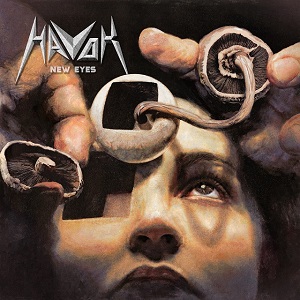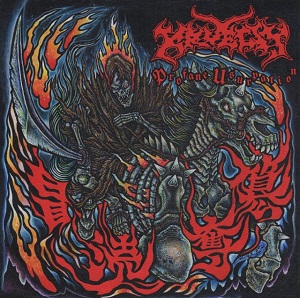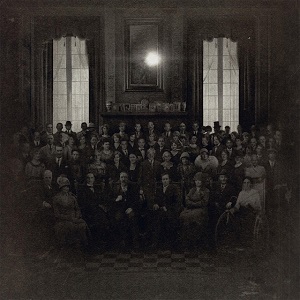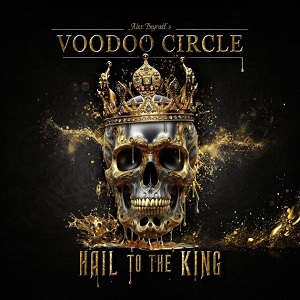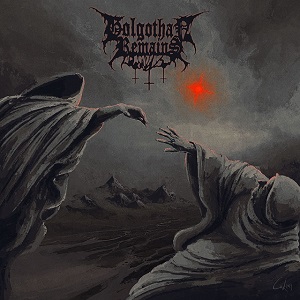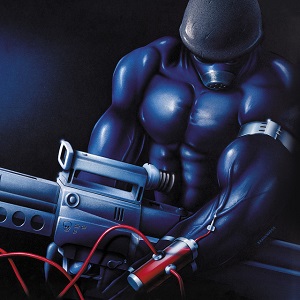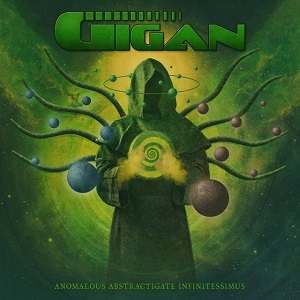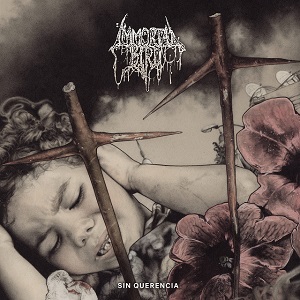HEADSTONES – “You’re Always Chasing Your Original Demos, Trying To Recapture The Initial Vibe”
October 25, 2022, 2 years ago
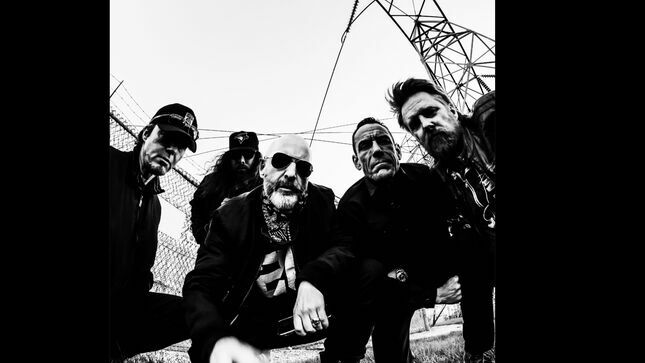
“It’s been a year in the works,” begins Headstones guitarist Trent Carr, as he settles in for a detailed discussion about his band’s new album, Flight Risk, available now via Known Accomplice. “We didn’t see each other in person for almost a year and a half cause of Covid, but we were always in touch. Hugh (Dillon – vocals / harmonica) and I Facetimed every couple of days, sending ideas back and forth, same with me and Tim (White – bass), and my brother (Steve Carr – keyboards). So, we were sort of half-assed working on new ideas, not sure what we were doing. By the time we figured it out, everybody took a Covid test, and we had a rehearsal – that was October of last year. We had one or two songs kind of done… it’s always that funny moment where it’s like, ‘We have nothing. How are we going to make a whole record?’ Then all of a sudden, sh*t just starts pouring out and you have 13 or 14 songs. It’s like magic.”
The cover art for Flight Risk features a tremendous image of an abandoned plane wreck. Trent explains where Headstones got that photo from. “This guy was working on our website, coming up with ideas, and Hugh jumped on the photo. I think that’s a plane that’s crashed in Iceland, and you can actually walk up to it; it’s just sitting there on the beach from 50 years ago. It’s just a cool shot the guy had. He was putting Headstones imagery around it, and we kept on working with him to develop that idea. We had a whole other idea that was in place, which we might use in the future. Then that just sort of took over, and we loved that image as well.”
And the phrase, Try To Act Normal, which is spray-painted across the plane, “is the magic of Photoshop. We had this whole other concept for artwork that had a lot of graffiti involved. We stole a couple of pieces from that idea and put them on this idea.” That slogan, along with the band name and album title pop out immediately. Upon closer inspection, the original Headstones logo – the H with the snake – and the skull with the name placed like a mohawk, can also be found on the fuselage; they’re almost like Easter Eggs. “Yeah, exactly. We love that kind of sh*t. We love detailed artwork with hidden things you don’t notice at first. That’s the kind of stuff we like to look at, so when we get a chance to do it, we love it.”
It's rather ironic because, by definition, Flight Risk is a person thought likely to leave the country before their trial. No one’s going anywhere on that plane! “It’s funny, the whole Try To Act Normal thing was another sort of… we were f*cking around with that idea as a title of something. Hugh and I had these hilarious pictures (which can be seen below) of each other – beards grown out; hair grown out during lockdown. We were just joking around with Try To Act Normal. It kind of goes with the whole Covid lockdown attitude, you just try to act normal.”

Flight Risk is being touted as “The most subversive Headstones record to date.” That’s an interesting statement as the word subversive means trying to destroy or damage something, especially an established political system. “That’s Hugh. Hugh is the wordsmith in the band usually. It’s just like subversing yourself, your own art, your own take on things. You should always be tearing down your own beliefs, not just relying on pre-conceived ideas. It’s a way of always challenging yourself to look at things in a different way.”
Hugh Dillon is a tremendous lyricist, and after pausing for a moment to think, Trent says “Neon Rome” might be the song from Flight Risk that impressed him the most lyrically. “It’s more of a deep cut track on the album. Neon Rome was a band in the ‘80s in Toronto that we all loved. They didn’t really ever go anywhere, but they had this insane stage presence, and cool songs. And we always loved the name. Hugh was f*cking around with that name, that word, that phrase, and the imagery of that song is so… I love when lyrics paint sort of an abstract image in your mind. It doesn’t necessarily have to make lyrical, narrative sense, but it has cool imagery. A Neon Rome is such a cool image, it’s like modern and ancient together. I love that kind of stuff. Hugh and I are big art fans. He’s always pushing me to make art stuff, because I went to art school before I was in a band. When I met Hugh, I was going to OCA in Toronto. We always connected on art stuff.”
“When It Goes Badly” references the year 1993. That’s the year Headstones released their debut album, Picture Of Health. “Mostly Hugh’s lyrics are about his personal journey through life, through addiction, through recovery. I don’t like to speak for him, what he actually meant with those lyrics. I just know that 1993 was a year of us getting our band together and not really taking care of ourselves during those years,” recalls Trent. “Those can lead you down some dark paths, and the people around you, you rely on them to pick you up; before you learn to pick yourself up. I think that’s sort of what it is. I don’t really like to… when we talk about lyrics, we don’t really talk about what the deep meaning of it is. It'll come out sometimes, but not all the time. I just like going with what I think it means. We don’t really discuss – I kind of get what Hugh’s talking about, cause I was there with him. It doesn’t necessarily even need to be said most of the time. I’m a big believer in people… you interpret it the way you do. The songwriter or the artist imposing what they were thinking when they wrote something, can be a negative to what you think of the song. I think it’s more important how the listener or the viewer interprets it. I have favorite songs, and I don’t know what the songwriter intended; but they mean something to me. If he says something contradictory, it’s just going to ruin it.”

Musically, “Psychotropic” is the most punk rock song on Flight Risk. “Oh yeah, 100%. That song started as a demo on GarageBand that I was f*cking around with. Hugh loved this one part of it, and we turned that into a song. It was way more metal in other parts that we ended up not using. That’s one of the interesting things about this record – we used a lot of demo tracks directly on the record. If Hugh did a vocal track on a demo, we might have used that exact take when we were in the studio properly. There’s a couple of guitar tracks I used from my GarageBand. A couple of vocal tracks Hugh used from his GarageBand. It was a real fun process that way because it felt like we weren’t… once you get into the studio, you’re kind of always chasing your original demos, and trying to recapture the initial vibe that inspired the song to be worked on in the first place. So, we’re like, just f*ck it. Why are we trying to chase down these guitar tones or vocal takes when we have it? Just use what we have, cause you get stuck in this mindset; especially engineers get stuck in the mindset that it’s got to be properly recorded with an expensive microphone and through these compressors. It’s like, who f*cking cares? Some of these vocal takes were recorded on Apple headphones,” chuckles Trent.
Conversely, there’s a track on Flight Risk called “Tangled”, which is very much a storyteller’s song. The music is more bare bones, it almost takes a back seat to the words. “That was a musical piece. Our drummer Jesse (Labovitz) actually came up with the riff for that one. Then we worked on it together as a band, and Hugh has a friend, he’s credited as a producer on our record, named Chris Osti; he’s been working with us for the last ten years. Hugh’s like a neighbor of his, so he goes over to his house, and this guy Chris will record Hugh’s ideas, put his ideas down, and then send those out to us. We’ll send back our musical ideas, and Chris helps put it all together on his computer before we even get into a rehearsal situation. Then we’ll have a skeleton idea of what to work on. From that point, you just jam it out as a full band, and everyone has little bits of input for arrangements and sounds. You start throwing ideas at it and see what sticks.”
“Ashes” is a very different song for a couple of reasons. It’s chilling in nature, which is unexpected. It also features an orchestral intro and outro, and it was co-written with actor / screenwriter / director Taylor Sheridan (Sons Of Anarchy, Sicario, Hell Or High Water). “That’s one that was written during lockdown, when Hugh was acting in (the Paramount television series) Yellowstone. He was in Montana filming Yellowstone, and I sent him an acoustic track. I had the musical arrangement down, and I didn’t have any vocal ideas, as usually is the case. That’s one of the examples I was describing about using GarageBand. That song was almost 100% recorded on GarageBand. We were sending it back and forth, and Hugh was with Taylor everyday, showing him the song. There was some lyrics, I guess, floating around between the two. They were talking about it, and then we used some lyrics that Taylor wrote. Once the lyrics were all done, I was messing around with it more on my GarageBand, putting strings down. And one thing great about having Jesse in the band, our drummer for the past five years, his mother is the lead violinist for Toronto Symphony Orchestra. And she loves helping out! We’ve just got to put in the call to have her come down to the studio. She is super excited about helping out. So, she recorded all those strings. She did that for the last record too, with a song called ‘Motorcade’. She did a whole arrangement of strings on that song. That was a real satisfying recording. Once we got into the studio, we had Jesse put real drums on it. For example, the acoustic guitars are me playing into GarageBand. Hugh’s vocals are sung into GarageBand. You just move those tracks over into the real studio and build upon that.”
For those who aren’t familiar, GarageBand is recording software. “Yeah, it’s free Apple software that comes when you buy a phone, an iPad, or a Mac Computer, you get GarageBand on it. I have this thing called iRig, which plugs right into the iPad. I plug my electric guitar right into the iPad. It’s just so much easier for me. Then you can cut and paste riffs and come up with arrangements that way. I look at it like a sketch pad for ideas. Then once we get those going, we bring it into rehearsal, and make ‘em real.”
The video for “Everything Or Nothing At All” was shot at a jail in Pennsylvania. “That was filmed at the Pittsburgh Penitentiary – whatever it’s called. That’s where Hugh’s filming Mayor Of Kingstown right now; he’s still down there doing it. In the last few months, we had a few gigs in the summertime. He didn’t have much time to come home and rehearse. So, we would get in the van – Tim, Steve, Jesse, and I – and drive down to Pittsburgh. We’d hang out for a weekend. Hugh would get off set and we’d go for a four, or five, hour rehearsal. Since he’s been on set, Hugh had access to the set, obviously, and he said, ‘It looks pretty cool down here, why don’t we film a video down here?’ I had done this test idea on my own where I was flipping through the lyrics on my iPad and thought that was good. So, we went down there and walked around the prison doing that. It turned out pretty cool.”
The flipping of the lyrics is reminiscent of Bob Dylan’s video for “Subterranean Homesick Blues”, where the words are on big sheets of cardboard; cause obviously there were no iPads back then. “Yeah, it’s totally a modern version of that,” confirms Trent. Furthermore, it keeps the jail theme going as the videos for “Leave It All Behind” and “Dimes And Pennies” were both filmed at The Kingston Penitentiary in Ontario. “It kind of added a neat subtext to ‘Everything Or Nothing At All’ – with ‘You say you can’t win it.’ Just the idea of losing it all – you f*cked up and you’re in prison.”
The final track on Flight Risk, “Rink”, is an unusual Headstones song. It’s almost like a carnival soundtrack with Hugh just going off. “Totally. That’s one where Hugh and Chris were… Chris came up with the music for that one and Hugh was like, ‘That’s weird, I kind of like it.’ He started putting vocals down on it, but he didn’t know what to do with this song. It was kind of half-finished and he said, ‘Let’s do something really weird with it.’ So, I downloaded it to my GarageBand, f*cked around with the arrangement, and added distortion to the track. Then I had the idea of adding this rant. We were sort of inspired by a Christopher Hitchens speech, but we can’t just use Christopher Hitchens, so Hugh did a version of that. Songs like that, there’s no rules. We can do whatever we want. This is never going to be a song that’s going to pretend to go on the radio. It’s our little art piece for our own amusement. Usually, if you do something you like, other people will like it.”


